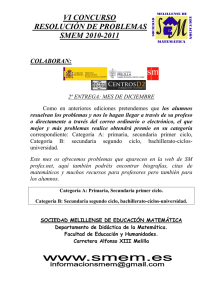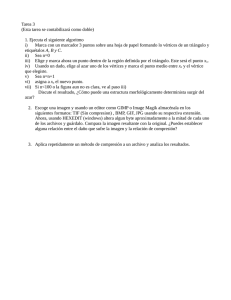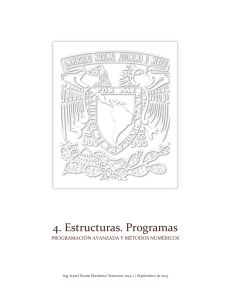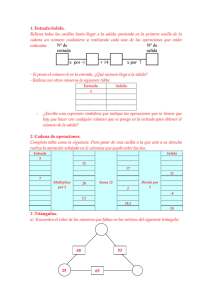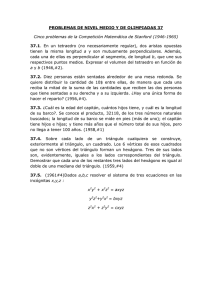Septiembre 2007 2.1
Anuncio
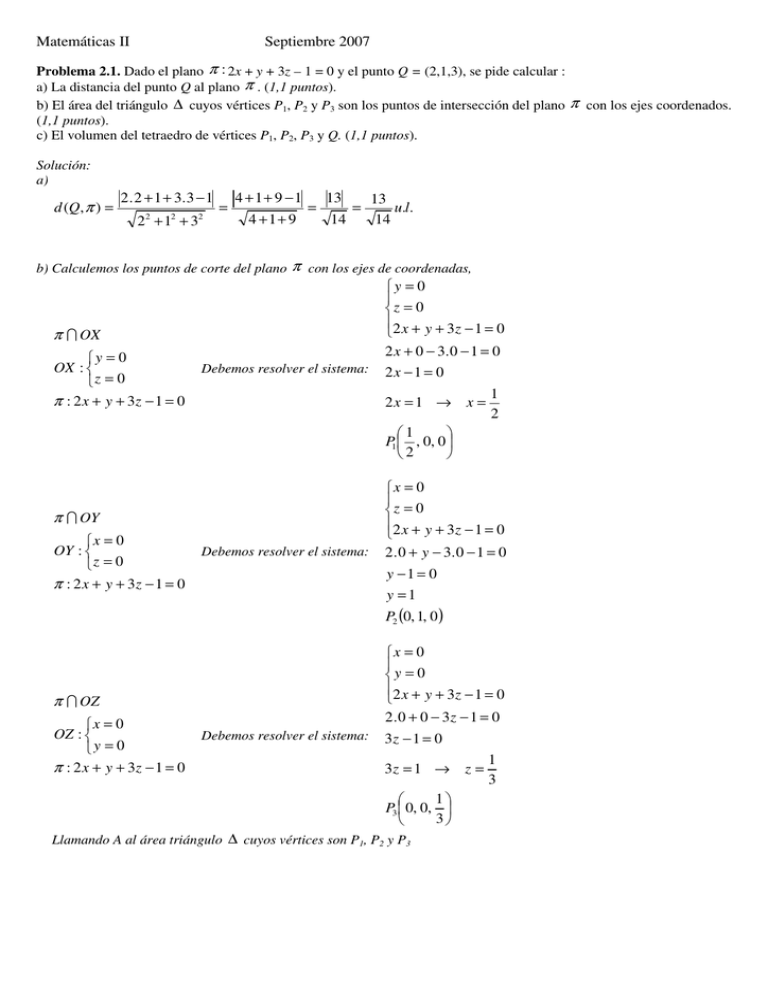
Matemáticas II Septiembre 2007 Problema 2.1. Dado el plano π : 2x + y + 3z – 1 = 0 y el punto Q = (2,1,3), se pide calcular : a) La distancia del punto Q al plano π . (1,1 puntos). b) El área del triángulo ∆ cuyos vértices P1, P2 y P3 son los puntos de intersección del plano π con los ejes coordenados. (1,1 puntos). c) El volumen del tetraedro de vértices P1, P2, P3 y Q. (1,1 puntos). Solución: a) d (Q, π ) = 2 . 2 + 1 + 3. 3 − 1 2 2 2 +1 + 3 2 = 4 + 1 + 9 −1 4 +1+ 9 = 13 14 = 13 u.l. 14 b) Calculemos los puntos de corte del plano π con los ejes de coordenadas, y = 0 z = 0 2 x + y + 3 z − 1 = 0 2 x + 0 − 3. 0 − 1 = 0 π I OX y = 0 OX : z = 0 π : 2 x + y + 3z − 1 = 0 Debemos resolver el sistema: 2x − 1 = 0 2x = 1 → x = 1 2 1 P1 , 0, 0 2 x = 0 z = 0 2 x + y + 3 z − 1 = 0 π I OY x = 0 OY : z = 0 π : 2 x + y + 3z − 1 = 0 Debemos resolver el sistema: 2 . 0 + y − 3. 0 − 1 = 0 y −1 = 0 y =1 P2 (0, 1, 0 ) x = 0 y = 0 2 x + y + 3 z − 1 = 0 π I OZ x = 0 OZ : y = 0 π : 2 x + y + 3z − 1 = 0 2 . 0 + 0 − 3z − 1 = 0 Debemos resolver el sistema: 3z − 1 = 0 3z = 1 → z = 1 P3 0, 0, 3 Llamando A al área triángulo ∆ cuyos vértices son P1, P2 y P3 1 3 A= → 1 → P1P2 × P1P3 2 → −1 P1P2 ,1,0 2 → −1 1 P1P2 ,1, 2 3 → → → i j → → −1 P1P2 × P1P3 = 1 2 −1 0 2 k −1 −1 0 → 1 →1 →1 →1 1 0 → 1 −1 1 2 2 1 0 =i − j +k = i − j +k = , , 0 −1 1 −1 3 6 2 3 6 2 0 3 1 2 3 2 3 → 2 y 2 2 → → 1 1 1 1 −1 1 P1P2 × P1P3 = + + = + + = 9 36 4 3 6 2 4 +1+ 9 14 14 = = 36 36 6 Finalmente, A= 1 14 14 = u.a. 2 6 12 c) 1 0 0 2 1 V ( P1 , P2 , P3 , Q) = 1 0 1 10 = 61 0 0 3 1 2 1 3 1 1 0 0 1 2 1 1 = −1 0 0 −1 1 6 3 2 1 3 1 1 2 0 2 (desarrollando el determinante por la 3ª columna) 0 1 1 − 1 1 2 3 1 1 1 2 3 1 4 + 9 13 = − 1 − + + = = u.v. − − − = 3 6 36 6 6 3 2 6 6 6 3 2 6 6 3
